Introduction
Since the beginning of the COVID-19 pandemic in March 2020, the Government has made a major effort to support the livelihoods of low-income households through increases in various working-age benefits, including the ‘uplift’ to Universal Credit (UC) and Tax Credits, with claimants seeing a weekly £20 increase in their benefit payments. While the uplift was withdrawn in September 2021, the Government has reduced the taper rate from 63% to 55% for UC claimants in work and increased the work allowance for some UC claimants. It is notable that those still claiming the benefits which UC has replaced, such as Jobseeker’s Allowance and Employment and Support Allowance, have, for the most part, not received any additional support throughout the pandemic.
While the provision of the uplift to UC and WTC claimants only was to specifically provide support for new claimants, who were suffering a sudden loss of income, it is important to consider that all benefit claimants faced substantive challenges to their financial and mental wellbeing before and during the pandemic.
Investigating newly published data from the 2019-20 UK Household Longitudinal Study, this analysis piece provides a snapshot of the financial, mental and social wellbeing of different groups of benefit claimants in 2019-20, just before and during the initial year of the pandemic.
Methodology
Bright Blue used survey data from the from the 2019-20 UK Household Longitudinal Study to perform original analysis examining the living costs, mental wellbeing and social connections of a variety of working-age benefit claimants just before and in the first year of the pandemic, as the survey was conducted between January 2019 and December 2020.
All survey data has been weighted to be representative of the adult population of the United Kingdom.
We focus on adults of working age (18 to 64 year olds) and examine six distinct population groups: UC claimants, Working Tax Credit (WTC) claimants, Jobseeker’s Allowance (JSA) claimants, Employment Support Allowance (ESA) claimants, Income Support (IS) claimants, and those who were not receiving an income-replacement benefit at the time of the survey (‘the rest of the population’)
Table 1. Unweighted sample sizes of each group of interest
| Claiming | None | UC | WTC | JSA | ESA | IS |
| Sample size | 20,199 | 1,080 | 772 | 175 | 789 | 422 |
Source: University of Essex, Institute for Social and Economic Research, NatCen Social Research, Kantar Public. Understanding Society: Wave 11, 2019-2021, (2021).
It is important to note that WTC, JSA, ESA and IS are all legacy benefits, which have been fully replaced by UC since January 2019. With very few exceptions, it is not possible to make a new claim for one of these legacy benefits, meaning that all legacy benefit claimants would have been receiving this benefit since at least January 2019, and in many cases from before then.
Finally, while all of the above benefits are usually mutually exclusive, meaning individuals can only claim one of them, there are some rare circumstances where an individual might be in receipt of more than one of the above benefits at the same time. In such cases, the individual is counted in the statistics of all the benefits they receive.
Financial wellbeing
We begin by finding that a significant minority of working-age benefit claimants were not up to date on housing (i.e. renting or mortgage costs) and Council Tax payments in 2019-20, as shown in Chart 1 below.
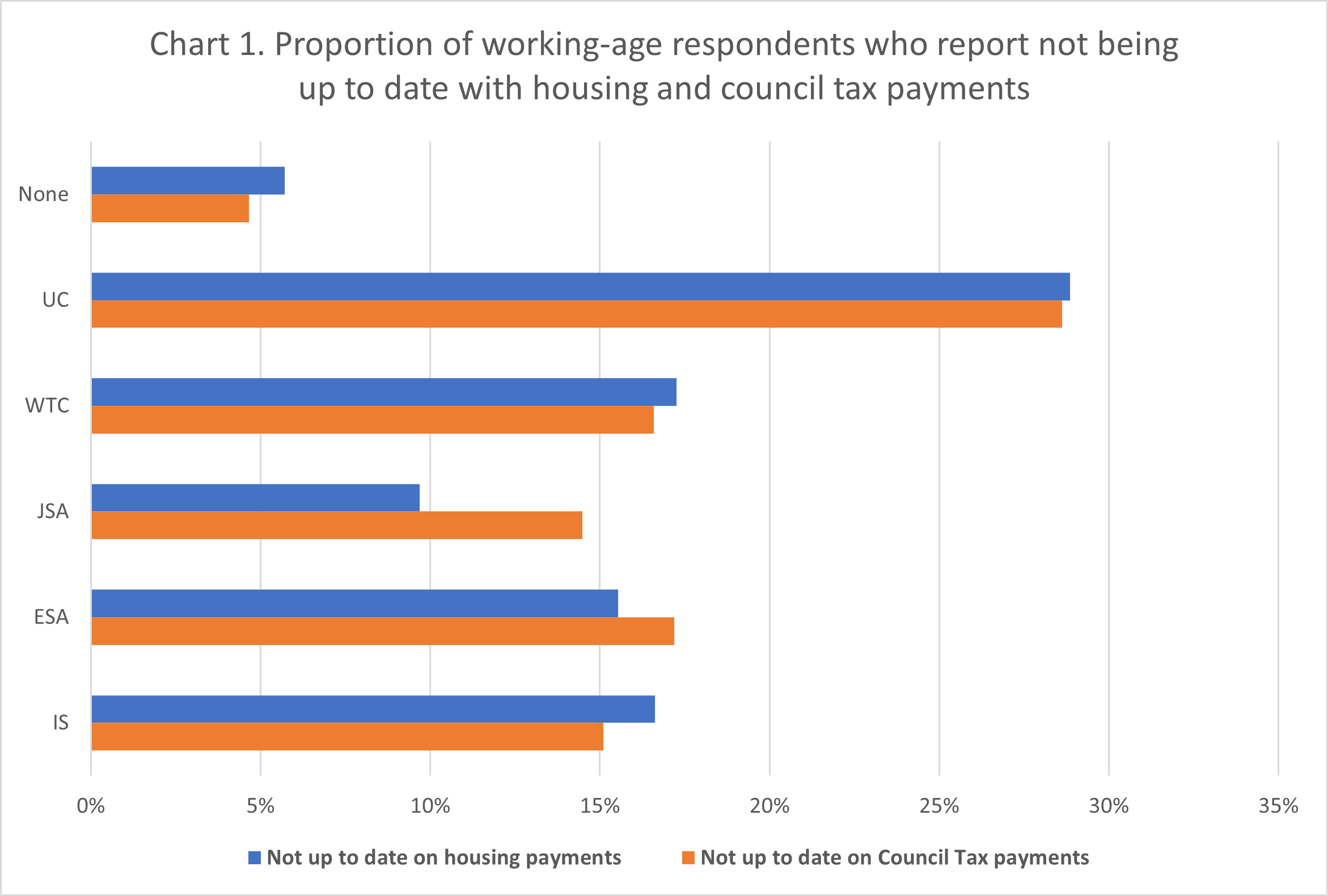 Source: University of Essex, Institute for Social and Economic Research, NatCen Social Research, Kantar Public. Understanding Society: Wave 11, 2019-2021, (2021).
Source: University of Essex, Institute for Social and Economic Research, NatCen Social Research, Kantar Public. Understanding Society: Wave 11, 2019-2021, (2021).
Echoing our earlier findings in Benefit to All, a significant minority of benefit claimants report not being up to date with housing and Council Tax payments in 2019-20. UC claimants are the most likely group to report struggling with housing (29%) and Council Tax (29%) payments. Claimants of legacy benefits, such as WTC, JSA, ESA and IS, are less likely than UC claimants to report not being up to date with housing (10% to 17%) and Council Tax (14% to 17%), but still notably more likely than the rest of the population (6% and 5% respectively).
A similar proportion of claimants struggled with household bills (such as utility bills) and with keeping their home warm in 2019-20, as seen in Chart 2 below.
 Source: University of Essex, Institute for Social and Economic Research, NatCen Social Research, Kantar Public. Understanding Society: Wave 11, 2019-2021, (2021).
Source: University of Essex, Institute for Social and Economic Research, NatCen Social Research, Kantar Public. Understanding Society: Wave 11, 2019-2021, (2021).
We find that a notable proportion of working-age benefit claimants report not being up to date with at least some household bills, and not being able to keep their home warm during winter. Once again, UC claimants are the most likely group to report struggling with household bills (31%), while ESA claimants, who are disabled, are in fact the most likely to report struggling to keep their home warm during winter (19%). Claimants of legacy benefits are less likely than UC claimants to report not being up to date with some household bills (13% to 20%). In comparison, the rest of the population were much less likely to report not being up to date with some household bills (4%) or not being able to keep their home warm during winter (3%) in 2019-20.
Mental wellbeing
Moving on to the mental wellbeing of working-age benefit claimants, we find that they were more likely to report poor mental wellbeing in 2019-20 than the rest of the population, as shown in Chart 3 below.
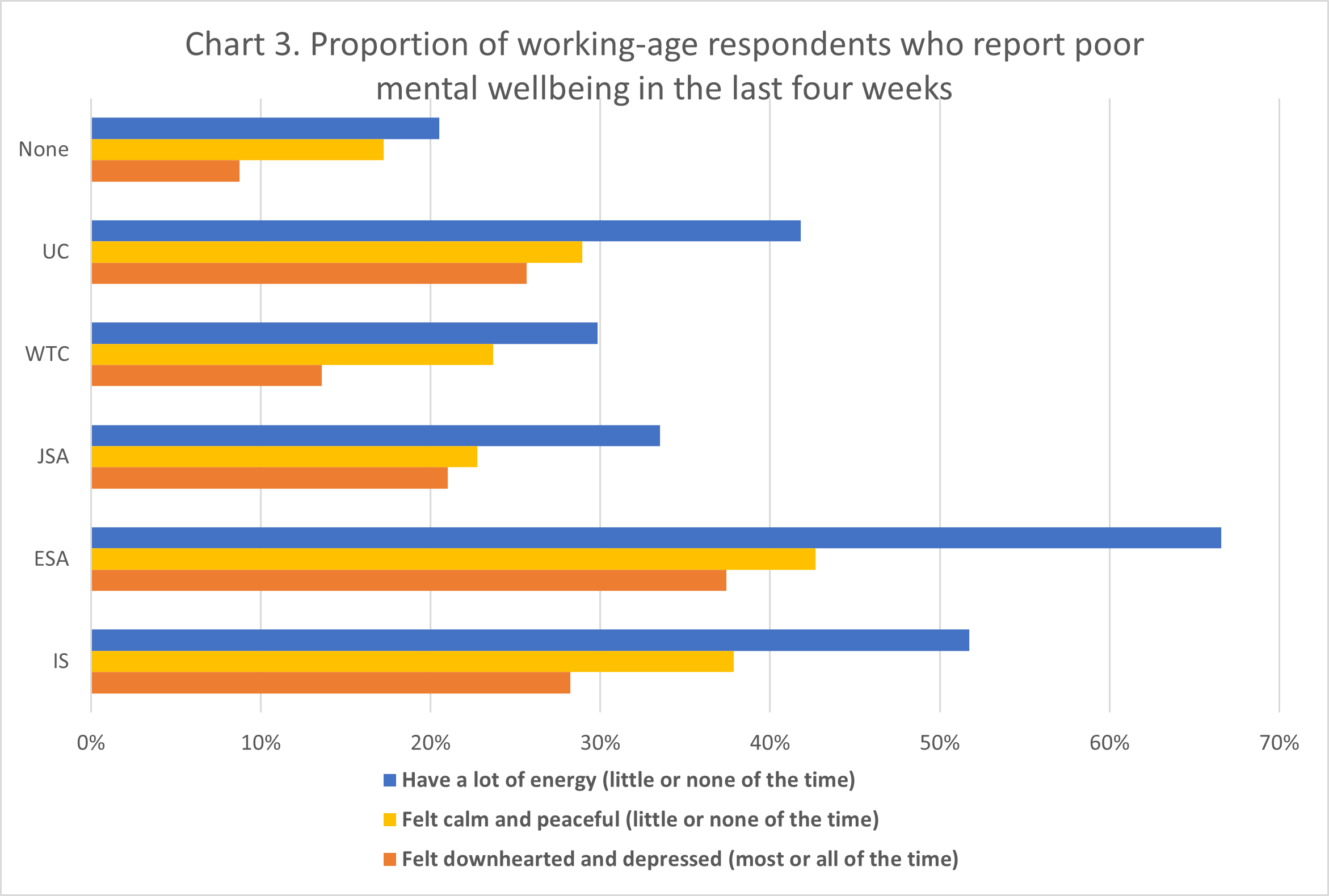 Source: University of Essex, Institute for Social and Economic Research, NatCen Social Research, Kantar Public. Understanding Society: Wave 11, 2019-2021, (2021).
Source: University of Essex, Institute for Social and Economic Research, NatCen Social Research, Kantar Public. Understanding Society: Wave 11, 2019-2021, (2021).
ESA claimants were the most likely to report rarely having a lot of energy (67%) or feeling calm and peaceful (49%) or frequently feeling downhearted and depressed (37%) in the past four weeks. This is unsurprising given that ESA claimants usually have long-term physical and mental health problems.
However, it is notable that claimants of all benefit groups are more likely to report indicators of poor mental wellbeing in the last four weeks, including those claiming WTC and JSA, in comparison to the rest of the population. Only 21% of the rest of the population reported rarely having a lot of energy, 17% that they rarely feel calm and peaceful, and only 9% that they felt downhearted and depressed most of the time.
Social wellbeing
Finally, considering social wellbeing, we find that working-age benefit claimants were also more likely to report feeling a lack of social connections in comparison with the rest of the population in 2019-20, as shown in Chart 4 below.
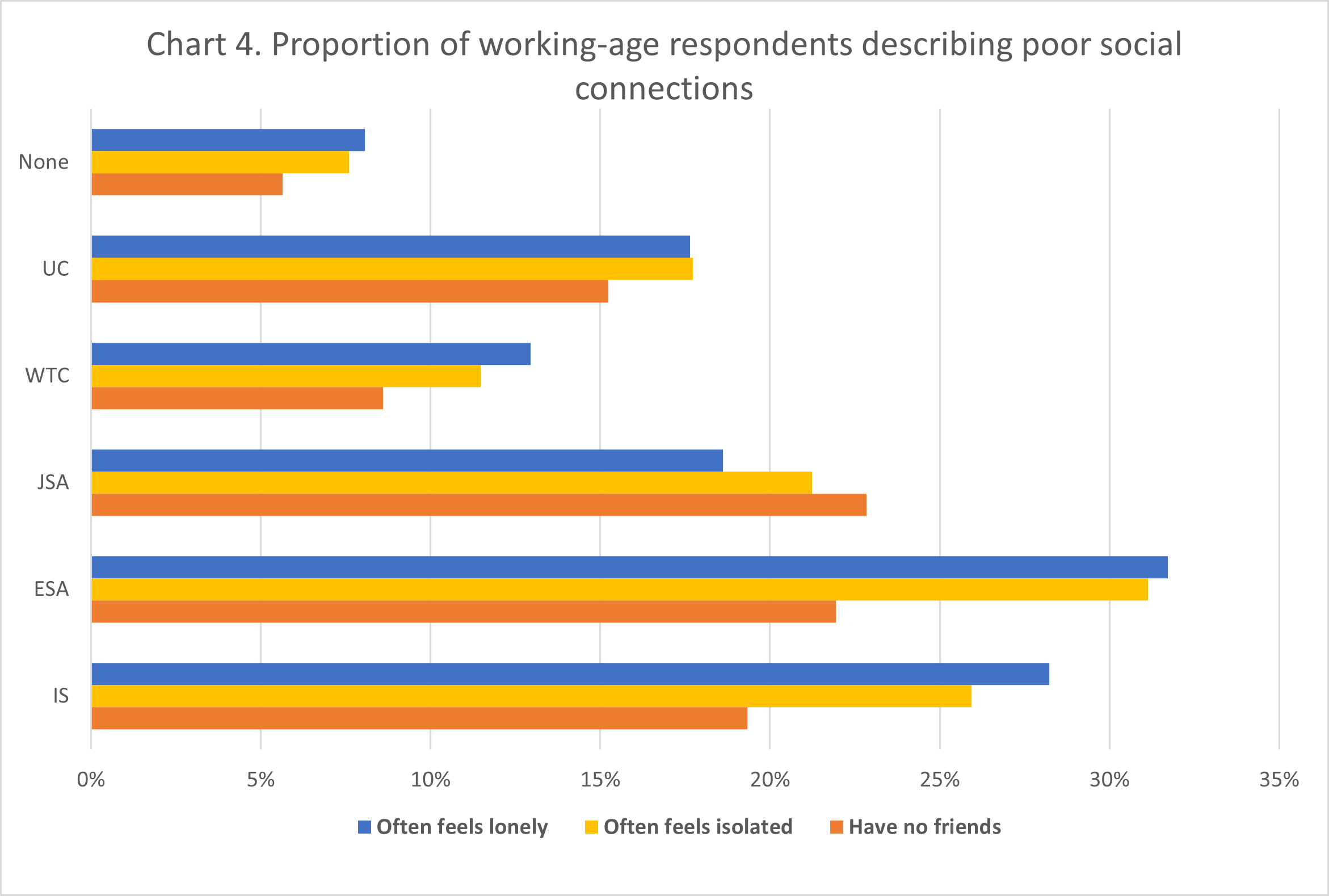 Source: University of Essex, Institute for Social and Economic Research, NatCen Social Research, Kantar Public. Understanding Society: Wave 11, 2019-2021, (2021).
Source: University of Essex, Institute for Social and Economic Research, NatCen Social Research, Kantar Public. Understanding Society: Wave 11, 2019-2021, (2021).
Once again, ESA claimants tend to be the most likely to report feeling that they have a lack of social connections of all types, with 32% reporting often feeling lonely, 31% reporting often feeling isolated and 22% reporting having no friends, though this is expected given that many ESA claimants have health problems which limit their mobility and opportunities to socialise.
However, other groups of claimants are also more likely to feel lack of social connections, with 28% of IS claimants, 19% of JSA claimants, 18% of UC claimants and 13% of WTC claimants reporting often feeling lonely, in comparison to 8% of the rest of the population. Meanwhile, 26% of IS claimants, 21% of JSA claimants, 18% of UC claimants and 11% of WTC claimants often feel isolated, in comparison to 8% of the rest of the population. Similarly, while 23% of JSA claimants, 19% of IS claimants and 15% of UC claimants report having no friends, only 9% of WTC claimants and 6% of the rest of the population reported the same.
Benefit claimants were not only more likely to lack social connections in 2019-20, but less likely to be able to rely on the social connections that they do have as a support network, as shown in Charts 5 and 6 below.
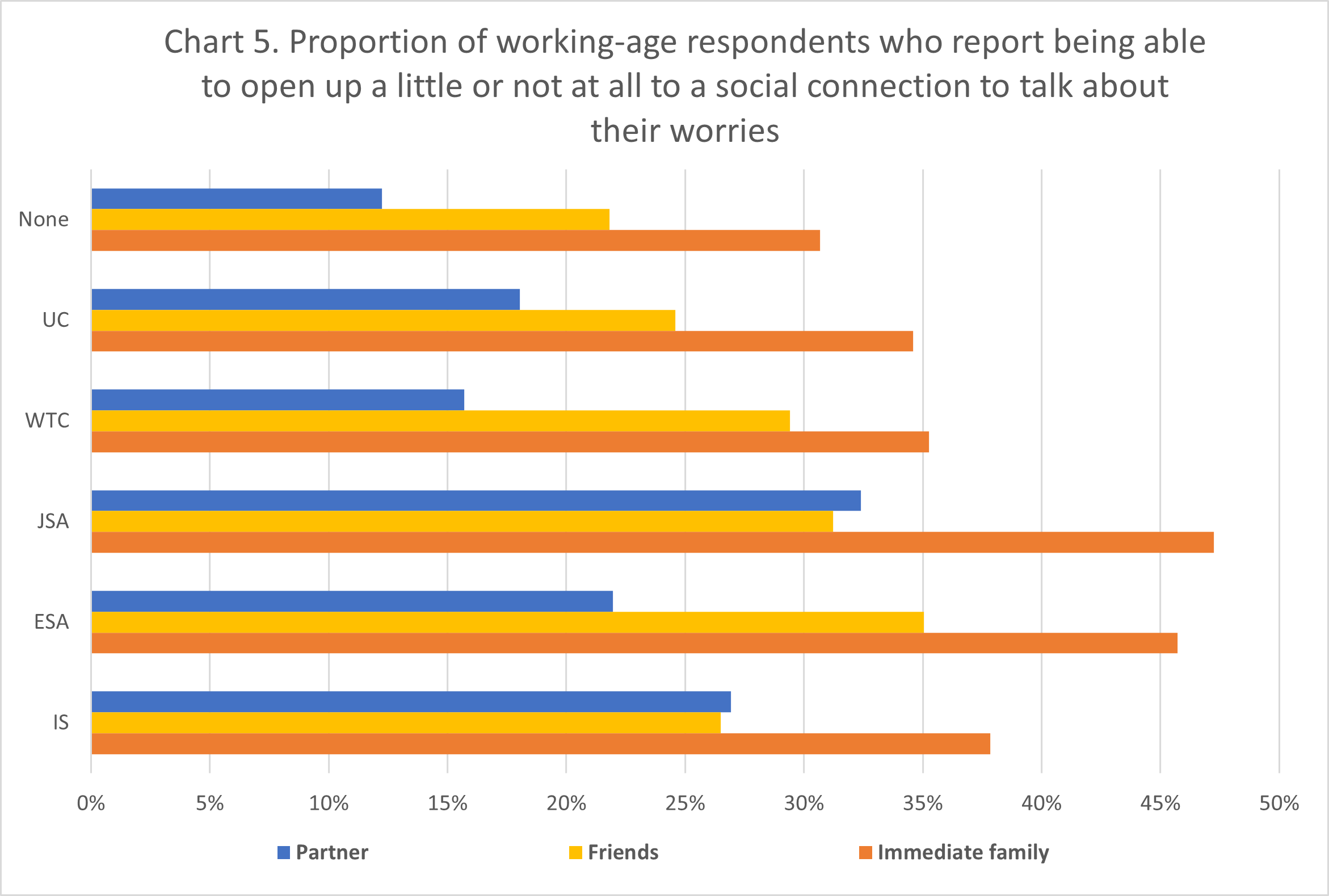 Source: University of Essex, Institute for Social and Economic Research, NatCen Social Research, Kantar Public. Understanding Society: Wave 11, 2019-2021, (2021).
Source: University of Essex, Institute for Social and Economic Research, NatCen Social Research, Kantar Public. Understanding Society: Wave 11, 2019-2021, (2021).
Benefit claimants tend to be slightly less likely to report being able to talk about their worries with someone in their social network, whether it is a partner, friends or immediate family. JSA claimants and ESA claimants in particular are more likely to report only being able to open up a little or not at all to their partner (32% and 22% respectively), friends (31% and 35% respectively) and immediate family (47% and 46% respectively). The quality of social connections of UC and WTC claimants is less poor, particularly in terms of their partners, where 18% and 16% respectively report not being able to open up about their worries. In comparison, 12% of the rest of the population report the same sentiment about their partner, 22% about their friends and 31% about their immediate family.
Similar disparities are found for working-age benefit claimants when asked about being able to rely on a social connection in 2019-20 if they have a serious problem, as shown in Chart 6 below.
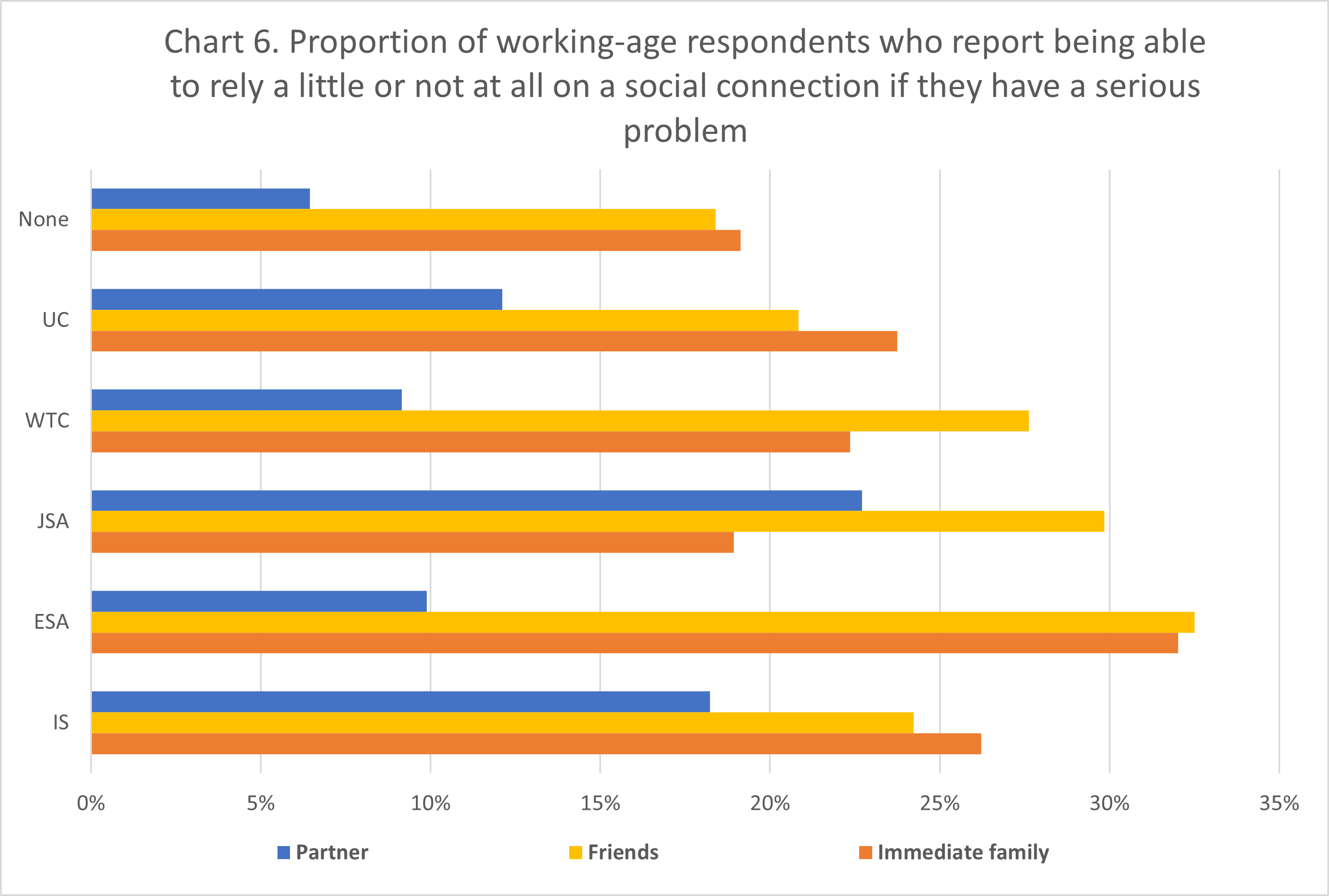 Source: University of Essex, Institute for Social and Economic Research, NatCen Social Research, Kantar Public. Understanding Society: Wave 11, 2019-2021, (2021).
Source: University of Essex, Institute for Social and Economic Research, NatCen Social Research, Kantar Public. Understanding Society: Wave 11, 2019-2021, (2021).
ESA claimants are the most likely to report not being able to rely on their friends (33%) and immediate family (32%) if they have a serious problem, while it is JSA claimants that are most likely to report not being able to rely on their partner (23%). When looking at the rest of the population, they are more likely to report being able to rely on their connections if they have a serious problem compared to nearly every other benefit group, and only 19% reported being able to rely a little or not at all on their immediate family, 18% on their friends and 6% on their partner.
Conclusion
This analysis piece has highlighted that all groups of benefit claimants, especially those on legacy benefits, experienced poorer financial, mental and social wellbeing than the rest of the population in 2019-20, the year when the COVID-19 pandemic first struck the world. All of this was despite the financial support provided to some benefit claimants during the pandemic.
First, it is vital to highlight that in 2019-20 at the beginning of and even just before the pandemic, a significant minority of all groups of benefit claimants struggled with a range of living costs, including housing payments, Council Tax payments, household bills generally, and heating costs specifically. While UC and WTC claimants received additional help during the first 18 months of the pandemic through the £20 a week uplift, and UC claimants in work are now able to keep a greater portion of their wages and benefits through a taper rate reduction in November 2021, most legacy benefit claimants did not receive additional help during the pandemic, and are now facing increasing living costs, especially in terms of heating as a result of rising energy prices.
Second, all groups of benefit claimants are more likely to experience issues with mental and social wellbeing than the rest of the working-age population, indicating the need for many benefit claimants to have stronger support networks.
With rising inflation, it will be vital for the Conservative Government to monitor closely whether a significant number of benefit claimants, particularly those claiming legacy benefits, will face increasing financial hardship, while lacking the social connections that might be able to help them directly or indirectly.
[Image: Liza Summer]





